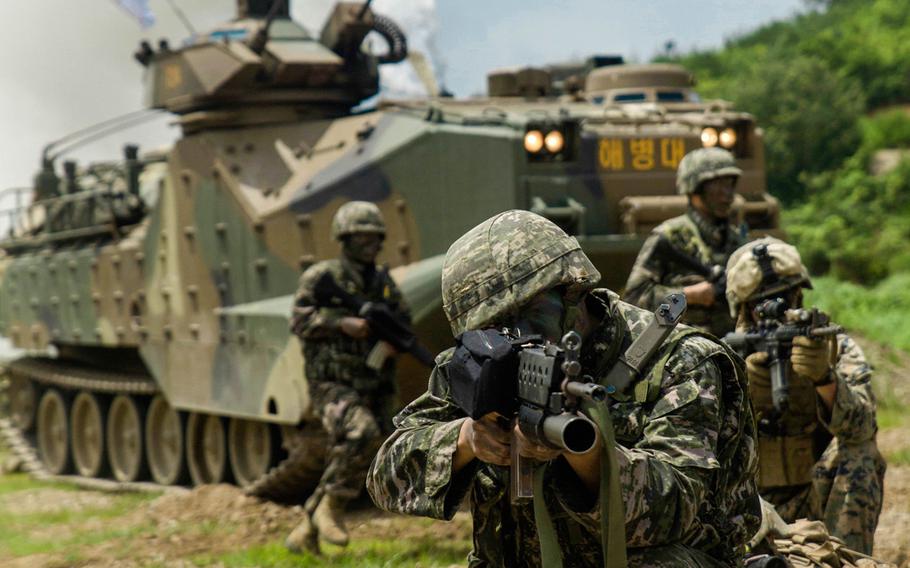
A Republic of Korea Marine sights in alongside U.S. Marines as ROK Assault Amphibious Vehicles shoot off smoke behind them July 6, 2016 at Suseong Range, South Korea, during a Korean Marine Exchange Program. The goal of the KMEP is to sustain the combined force and enhance the ROK-U.S. team at the tactical level to build combined war fighting capabilities. During this exercise, the Marines carried out a bilateral regimental-sized Marine Air Ground Task Force operation for the first time. The ROK Marines were a part of 73rd Battalion, 7th Regiment, 1st Marine Division. The U.S. service members are a part of 2nd platoon, Fox Company, 2nd Battalion, 2nd Marine Regiment, currently attached to 4th Marine Regiment, III Marine Expeditionary Force through the unit deployment program. (U.S. Marine Corps photo by Lance Cpl. / Released) (Amaia Unanue/U.S. Marine Corps)
POHANG, South Korea — Long-distance relationships don’t always work. But the U.S. and Korean marines think they have found a winning formula.
The III Marine Expeditionary Force, based in Okinawa, Japan, deploys a steady stream of units to South Korea for joint training exercises with their Korean counterparts.
The most recent was a nearly monthlong Korean Marine Exercise Program, which involved about 900 marines from each side and culminated with a live-fire drill on July 6. It was the first so-called KMEP designed to develop bilateral air and ground command-and-control capabilities.
Artillery and mortar fire rocked an area in the lush green mountains surrounding the Suseong range outside the southeastern industrial port city of Pohang. Then a line of four tanks, each bearing a U.S. or Republic of Korea flag, advanced on the targets followed by Korean amphibious assault vehicles and a mine-clearing truck.
The plan was to use helicopters, amphibious assault vehicles, tanks and other weaponry to seize the enemy’s core facilities. But fear of heavy rains grounded the aircraft, so the marines improvised and sent trucks onto the field to simulate that part of the operation. The downpour began shortly after the mock attack was finished.
Maj. Matthew Deffenbaugh of the 2nd Battalion, 2nd Marines declared the exercise a success. He said the Koreans had practiced with Cobras and Hueys in previous days.
“This is the first time that at the regimental level the ROK Marine Corps has done anything like that … control the air component and the ground component at the same time,” he said. “We were there solely as a safety backstop. And we did not have to insert ourselves at all.”
The exercise programs are the primary way the U.S. Marines maintain readiness on the divided peninsula, where the threat from North Korea is ever present.
Unlike the Army, Air Force and Navy, the Marines don’t have a significant permanent presence in South Korea, so they rotate troops in from Okinawa for 30-45 days at a time. The allied marines hold about 20 engagements aimed at developing their tactical-level capabilities each year, giving them a “nearly continuous” presence.
The marines face stiff challenges in working together: There’s a language barrier, and the Koreans are mostly conscripts, leading to a constant flow of new faces in the lower ranks.
Deffenbaugh said translators help, but they’re often not familiar with technical terms.
“So there’s a lot of hand gestures, a lot of pointing at maps and pictures,” he said. “We work through everything … but it takes longer than if you have people who are speaking the same language.”
Commanders say Koreans get constant training in new equipment, tactics and procedures, while the Americans get mountain warfare and cold-weather training as well as experience in live fire, combined arms and maneuvers.
“We can do things here that we can’t do in Okinawa, so we come here a lot,” 3rd Marine Division commander Maj. Gen. Richard Simcock told Stars and Stripes.
“The ROK Marine Corps has developed capabilities very, very rapidly,” he added. “Our challenge … is to make sure that we’re compatible.”
Maj. Gen. Chang Ryong Choi, commander of the 1st Korean Marine Division, said it was crucial to learn from the American Marines, who are battle tested from the Iraq and Afghanistan wars.
“The exercises are an excellent opportunity for the units at the battalion level or lower to develop their capabilities,” Choi said in a joint interview with Simcock in Pohang. “In order to do so we need to share our tactics and we need to achieve the interoperability for our weapons systems” as well as command-and-control techniques.”
South Korea’s Marine Corps is striving to improve its aviation capabilities. This spring, it also formed a rapid-reaction force known as Spartan 3000.
Choi said the unit was created to stage special operations inside North Korea in the event of war.
“One of the main objectives of the quick maneuver force is to respond to the changing threats of North Korea,” he said. At other times, it will provide disaster relief and humanitarian assistance for other countries in need.
The Marines are not alone in relying on joint exercises with the Koreans. They also participate in major exercises with the U.S. Army and others that have drawn the ire of North Korea, which considers them a rehearsal for an invasion.
Simcock said that in addition to improving capabilities, the exercises are a show of strength.
“Our adversary watches very, very closely. They see our capabilities that we freely demonstrate,” he said. “The biggest strength is showing our adversaries how we work together, the capabilities that we have jointly developed.”
gamel.kim@stripes.com Twitter: @kimgamel